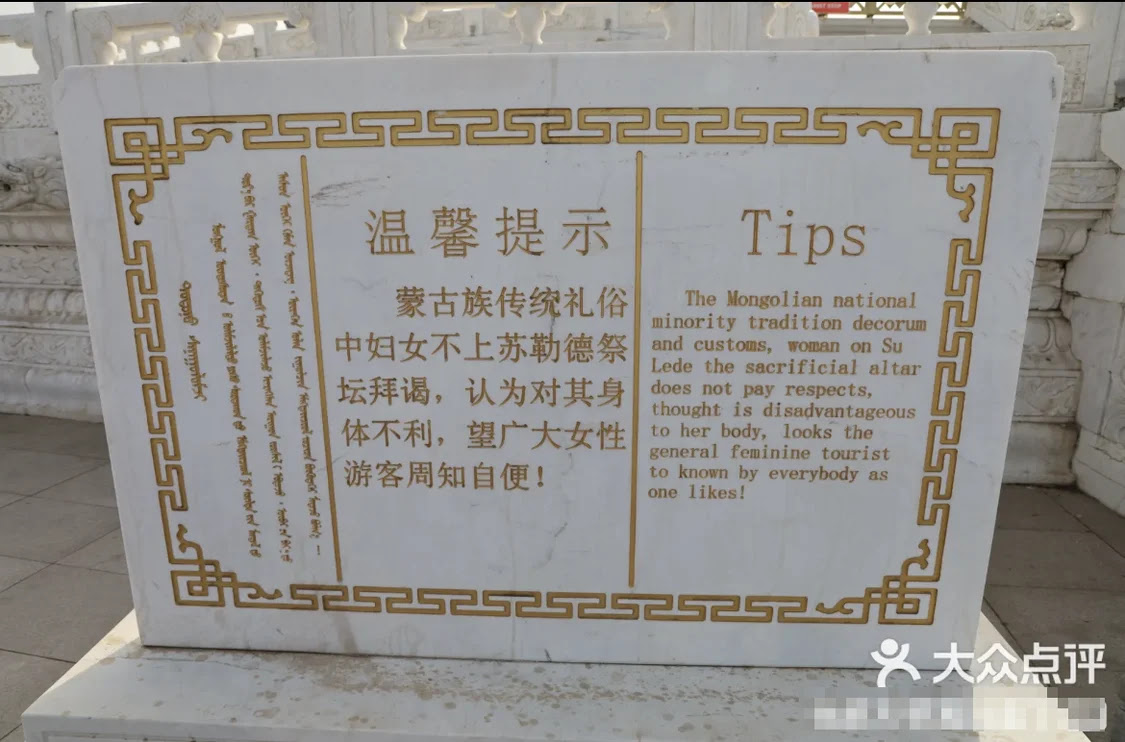Tuoba and Xianbei, part 2
Read the rest of this entry »
Read the rest of this entry »
Trilingual tablet at the altar of Genghis Khan (ca. 1162-1227) in Kandehuo Enclosure in the town of Xinjie, in the Ejin Horo Banner in the Ordos Prefecture of Inner Mongolia:

(source)
Read the rest of this entry »
James Millward sent in a very interesting and important communication (copied in full below) touching upon the ethnic composition of what has now become the Peoples Republic of China (PRC) a thousand and more years ago, especially its Turkic and Proto-Turkic components, together with its proto-Mongolic and para-Mongolic congeners.
Since it is of crucial significance for the early middle, middle, and modern history of the East Asian Heartland (EAH) and Extended East Asian Heartland (EEAH) (see the second item by Victor H. Mair in the "Selected readings"), this is a topic that I have long wanted to address in extenso on Language Log, so I welcome Professor Millward's timely submission on the origins and identification of "Tuoba".
Inasmuch as this lengthy post is chiefly about a group called Tuoba (in Modern Standard Mandarin [MSM] pronunciation of the Sinitic / Sinographic transcription of their ethnonym), supposedly a clan of a people called Xianbei (MSM pronunciation of the Sinitic / Sinographic transcription of their ethnonym), and because it is a very thorny and complicated issue having contemporary political implications, we had better gain a modicum of familiarity with who the Tuoba and Xianbei were, as well as where and when they lived.
Read the rest of this entry »
AntC sent in this snippet of Taiwan history overlaying today's native culture rights movement: Taiwan News (in English); Liberty Times Net (in Mandarin). The articles tell a tale of vast amounts of gold stashed away by Japanese colonialists and treasure seekers trying to find it now three quarters of a century later. The photograph of the excavation site in the latter article looks pretty hit or miss.
Allegedly, the fleeing Japanese occupiers buried gold somewhere near Taitung (city; county) in the Jhihben Hot Springs (Zhīběn wēnquán 知本溫泉) area. This is a steep gorge running into the mountains southwest of Taitung. There are plentiful thermal springs in the gorge, with huge resort-hotels that (before Covid) were a magnet for Japanese tourists.
Read the rest of this entry »
A comment to this post: "Accents you expect to hear" (4/6/22):
From Rob:
I was born and brought up in Zambia, a then-British colony. My (mainly) British parents made it clear that I was not to speak like a "jaapie", although that was the natural accent to use with my friends.
It's a name, but I never heard of it before. So I had to look it up, and it was worth the effort, because it raises some interesting questions.
Read the rest of this entry »
Etymological aficionado that I am, as I suspected "Ruthenian" is related to "Russian".
Some notes:
Related to Ruthene, Ruthenian, Ruthenic, from Medieval Latin Rutheni, Ruteni, related to Russi, Ruzi as Prutheni, Pruteni is to Prussi, Pruzi (“Prussians”). Compare Rus, Russ, from Old East Slavic Русь (Rusĭ), compare Byzantine Greek Ῥῶς (Rhôs).
(source)
Ditto for "Rusyn":
From Rusyn руси́н (rusýn), from Old East Slavic Русь (Rusĭ, “Rus”). Compare Ruthenia.
(source)
Read the rest of this entry »
[This is a guest post by Don Keyser, responding to Grant Newsham's "Rusyn" (3/22/22)]
This one brought back memories.
In 1959, my high school in Towson, just to the north of Baltimore, rose to the challenge posed by Sputnik and launched a Russian-language program. I had studied Latin for three years, and when invited to "enlist" (as a patriotic duty) in study of the enemy's language, I was delighted to abandon Latin … for my country, and otherwise. So I took two years of Russian in high school, and went on to study Russian language and Russian/Soviet area studies through undergrad and M.A. work. I only "defected" to Chinese/Japanese in PhD studies and thereafter in the U.S. government.
Anyway … my very first Russian language teacher was named Josef Glus. He had been teaching wood shop*, of all things, to kids not expected to go on to university. But he spoke Russian, and was tapped to teach the maiden course in that language offered by the high school. He was Ruthenian. I had to look up Ruthenia — in the days before a few taps of the fingers on a computer yielded up a map, the history, and so on.
[*VHM: For the concept of "shop" in the high school curriculum, see "The weirdness of typing errors" (3/14/22)]
Read the rest of this entry »
[This is a guest post by Bob Ramsey]

Fairy Tale-like Landscape in Guangxi
Millions in South China today, especially in Guangxi, are not Han Chinese at all, but “Tai.” Tai groups in China include, among others, the Dai, the Li, and the Zhuang. Culturally and linguistically related to the Thai (or Siamese) of Thailand, Tai in China don’t ordinarily stand out as different. They live among Han Chinese. Most look and act Chinese. They wear the same clothes. Most are bilingual in Cantonese or some other variety of Chinese. Nevertheless, the PRC classifies them as minorities, and some pose for the tourist trade, sporting exotic “native” clothes and putting on colorful festivals for paying visitors.
Read the rest of this entry »
Posted on Twitter by Xi Van Fleet (click on the "X" in the black circle at the top right of the photo to see the whole sign):
Shameless propaganda street sign by CCP. It is roughly translated as “You can pay back your parents for raising you. You will never be able to pay back the Party for what it has done for you”. pic.twitter.com/9RwegwIYwk
— Xi Van Fleet (@XVanFleet) February 24, 2022
Read the rest of this entry »
The ethnicity and language of the Xiongnu / Huns (the names are related, but that is not to say they are exactly the same peoples across the stretch of time during which they existed) have long been enigmas for scholars of Chinese and Inner / Central Asian history during the late first millennium BC and early first millennium AD. Recently discovered archeological evidence may shed new light on these puzzles.
Sogdians depicted in a Tang-dynasty tomb (716 AD). They're attendants of a deceased general who claims ancestry from Chanyu rulers of the Xiongnu empire. Since their defection to the Han dynasty in the 1st c AD, Xiongnu nobility had always been active in politics of North China. pic.twitter.com/AnXYqT5WZJ
— Jin Xu 徐津 (@xujnx) February 21, 2022
Read the rest of this entry »
[This is a guest post by Bob Ramsey]
Museum of Chinese Writing near Anyang*, in North China:

*First stable capital of the Shang / Yin Dynasty (c.1600-1046 BC) and the site of the discovery of the largest cache of oracle bone inscriptions (beginning of the Chinese writing system).
Read the rest of this entry »